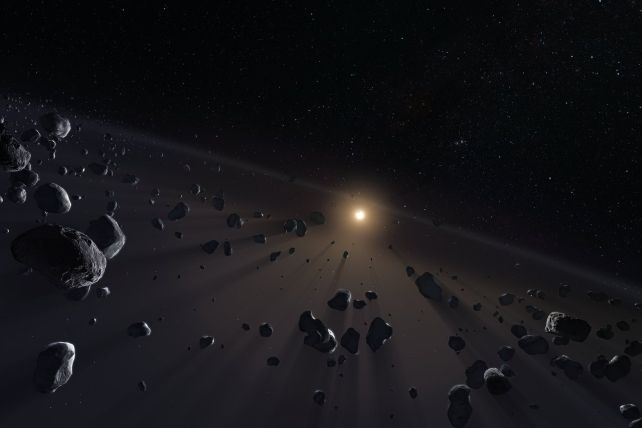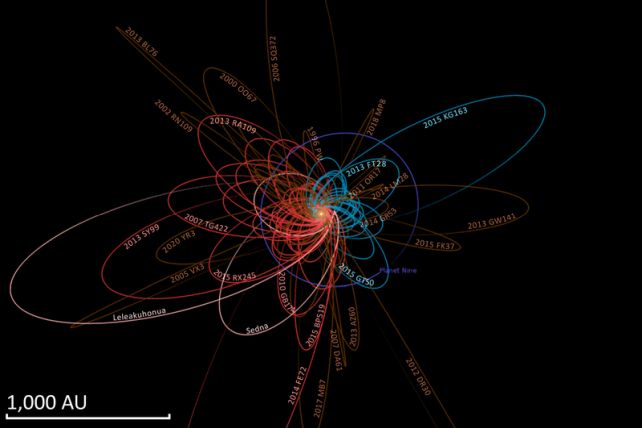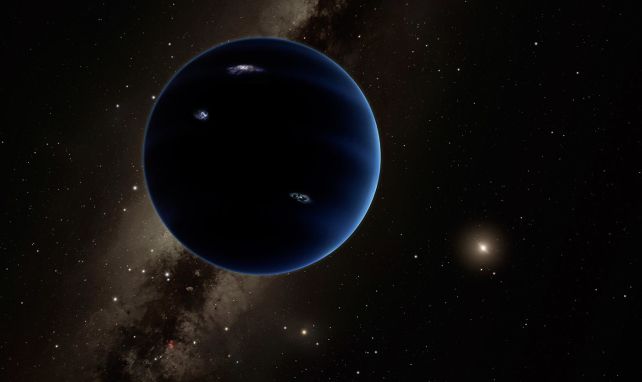The far reaches of the Solar System are a dim and distant realm with particulars that elude us. So far from the light of the Sun, even a relatively large planet could easily escape our notice.
The trans-Neptunian objects (TNOs) that we have found out there, beyond the orbit of Neptune, exhibit some peculiar clustering behaviors that could indicate the presence of a hidden world. This has led scientists to propose the idea of Planet Nine, a large terrestrial planet lurking far beyond the range of visibility.
Now, two scientists have come up with an alternative explanation: a more modest, Earth-like world, located much closer than the disputed Planet Nine, on a tilted orbit that could explain the curious behaviors attributed to the presence of something larger.
According to planetary scientists Patryk Sofia Lykawka of Kindai University in Japan and Takashi Ito of the National Astronomical Observatory of Japan, this world, frozen and dark so far from the Sun, would be no greater than 3 times the mass of Earth, and no farther than 500 astronomical units from the Sun.
"We predict," they write, "the existence of an Earth-like planet and several trans-Neptunian objects on peculiar orbits in the outer solar system, which can serve as observationally testable signatures of the putative planet's perturbations."

The most distant single object we've been able to find in the Solar System was at a distance of 132 astronomical units from the Sun when we found it. Pluto, for context, is at an average distance of about 40 astronomical units from the Sun.
But out past Neptune (30 astronomical units from the Sun) is a whole bunch of icy rocks and dwarf planets, extending out as far as we can see. This is the Kuiper belt, and the objects it contains are TNOs.
In recent years, with more sensitive telescopes and surveys, we've been able to find a whole bunch more TNOs than previously identified, which has allowed scientists to start noticing patterns.
One of those patterns is clustering. Some groups of TNOs bunch and move together in groups on inclined or tilted orbits that suggest they've been gravitationally influenced by something significantly larger than the smaller objects we've been able to spot to date.
In 2016, Caltech astronomers Mike Brown and Konstantin Batygin pointed at a hypothetical Planet Nine as the culprit. This planet is thought to be around 6.3 times the mass of Earth, orbiting at a distance greater than 460 astronomical units.

But they were not the first to provide an explanation. Lykawka and colleague Tadashi Mukai, then at Kobe University, noted TNO clustering and proposed a hypothetical hidden Kuiper belt planet in 2008.
Now, with a bunch more data on what's out there, Lykawka and Ito have revisited the idea and refined it. They have found the properties of a hypothetical planet that could explain several peculiarities of the Kuiper Belt. Further observations could determine whether they are right.
"We determined that an Earth-like planet located on a distant and inclined orbit can explain three fundamental properties of the distant Kuiper Belt: a prominent population of TNOs with orbits beyond Neptune's gravitational influence, a significant population of high-inclination objects, and the existence of some extreme objects with peculiar orbits," they write.
This Earth-like planet would have a mass between 1.5 and 3 times that of Earth, an orbit whose most distant point from the Sun would be between 250 and 500 astronomical units, and an inclination of 30 degrees respective to the plane of the Solar System.

Its presence could explain objects with inclinations greater than 45 degrees, and the orbits of objects such as dwarf planet Sedna, which has an exceptionally weird and elongated orbit. It could also explain the properties of groups of TNOs that do seem linked to Neptune, and that are often left out of such studies.
The pair's findings offer testable signatures of their hypothetical planet. The planet's gravity would push TNOs together into clustered populations beyond 150 astronomical units, which we might be able to find as our techniques and instruments improve.
"More detailed knowledge of the orbital structure in the distant Kuiper Belt can reveal or rule out the existence of any hypothetical planet in the outer solar system," they write. "The existence of a Kuiper belt planet may also offer new constraints on planet formation and dynamical evolution in the trans-Jovian region."
The research has been published in The Astronomical Journal.
https://news.google.com/rss/articles/CBMiZGh0dHBzOi8vd3d3LnNjaWVuY2VhbGVydC5jb20vc2NpZW50aXN0cy10aGluay1hbi1lYXJ0aC1saWtlLXBsYW5ldC1tYXktYmUtaGlkaW5nLWluLW91ci1zb2xhci1zeXN0ZW3SAQA?oc=5
2023-09-01 02:36:38Z
CBMiZGh0dHBzOi8vd3d3LnNjaWVuY2VhbGVydC5jb20vc2NpZW50aXN0cy10aGluay1hbi1lYXJ0aC1saWtlLXBsYW5ldC1tYXktYmUtaGlkaW5nLWluLW91ci1zb2xhci1zeXN0ZW3SAQA
Bagikan Berita Ini















0 Response to "Scientists Think an Earth-Like Planet May Be Hiding in Our Solar System - ScienceAlert"
Post a Comment